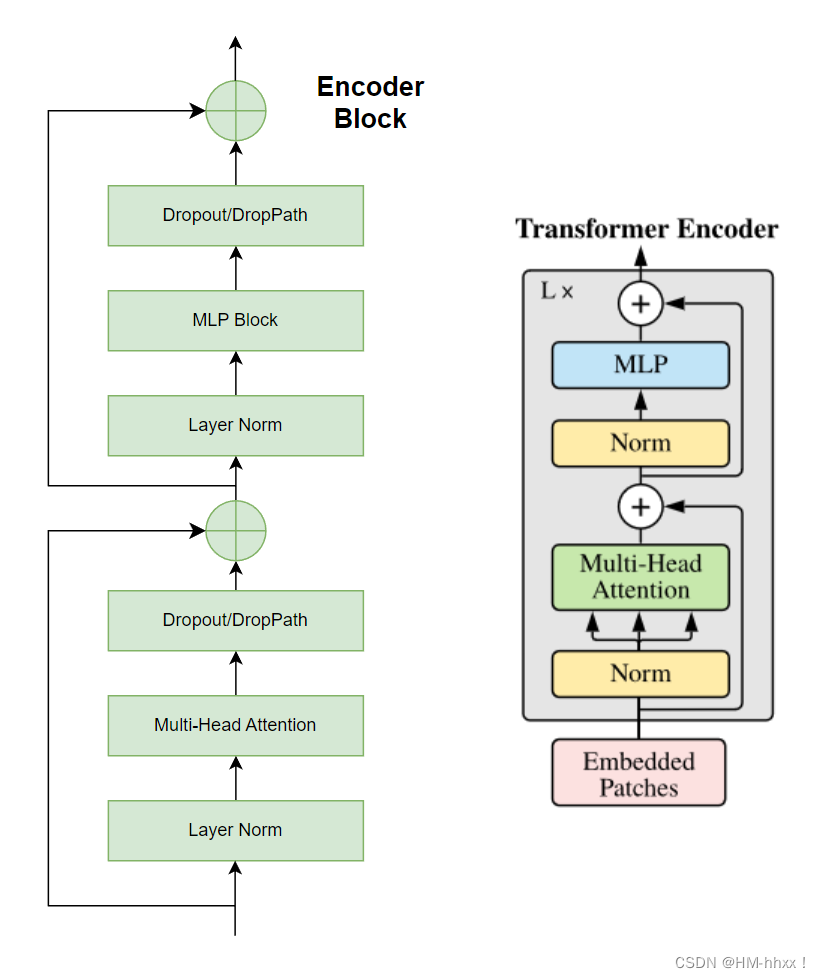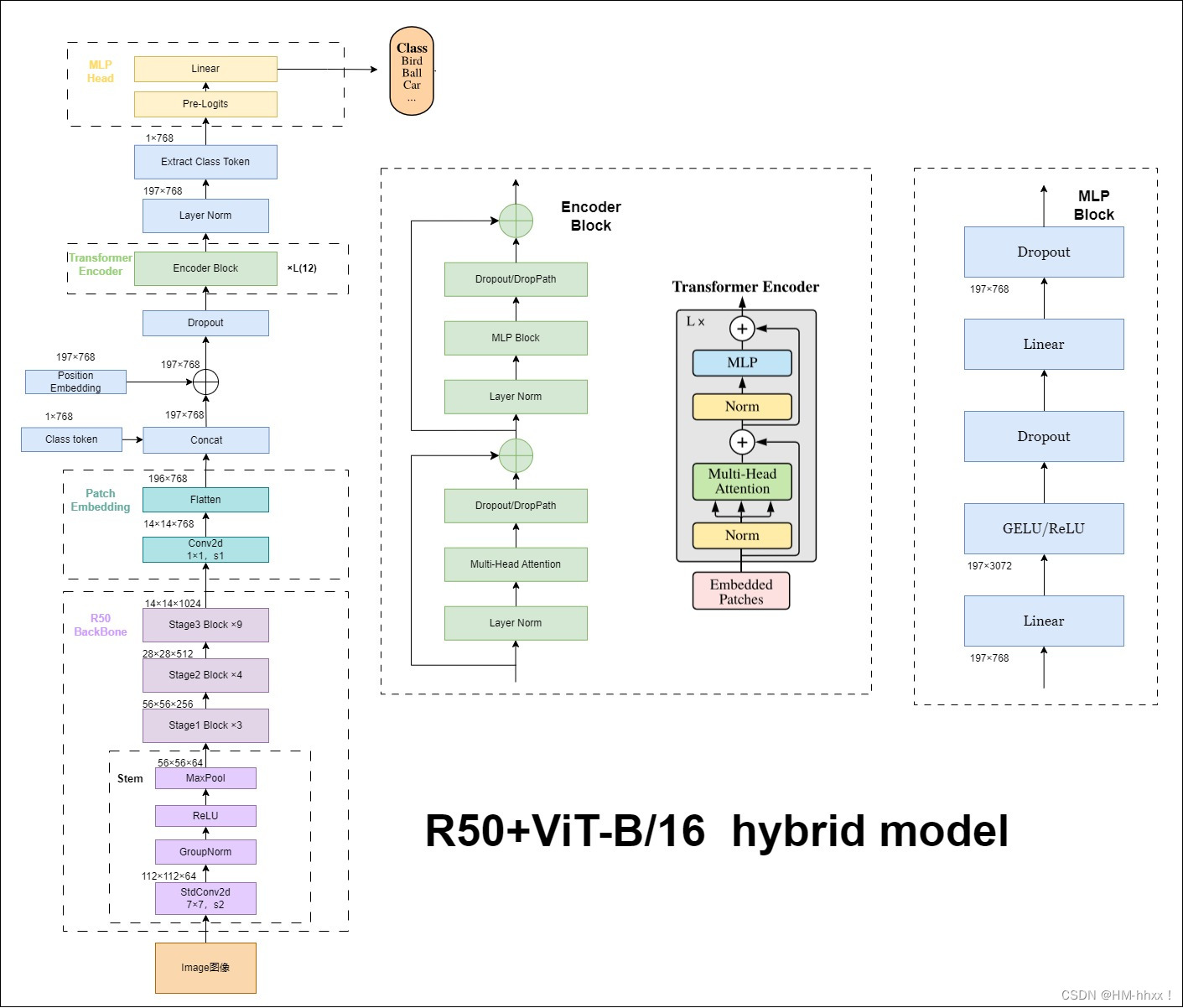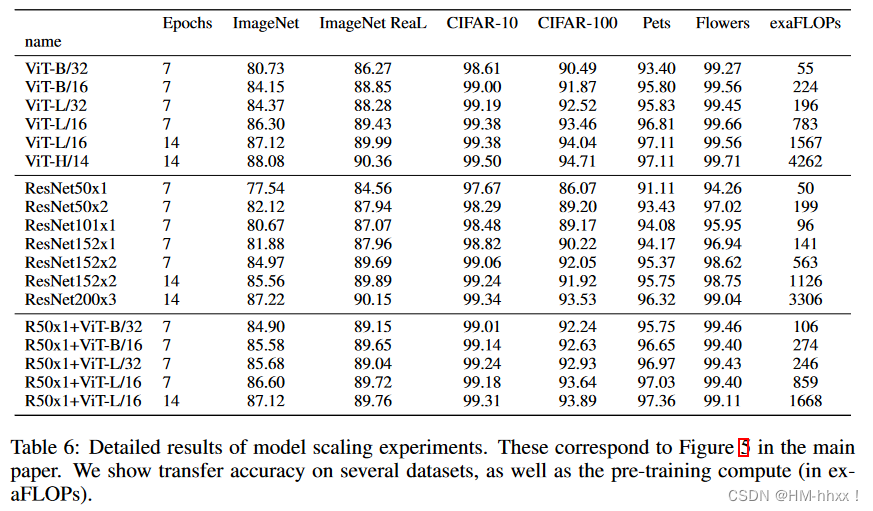目录
1.1 Linear Projection of Flattened Patches
0.Vision Transformer介绍
2017年Vaswani等人在发表的《Attention Is All You Need》中提出Transformer模型,是第一个完全依靠自注意力计算其输入和输出的模型,从此在自然语言处理领域大获成功。
2021年Dosovitskiy等人将注意力机制的思想应用于计算机视觉领域,提出了Vision Transformer(ViT )模块。在大规模数据集的支持下,ViT模型可以达到与CNNs模型相当的精度,如下图所示为ViT的不同版本与ResNet和EfficientNet在不同数据集下的准确率对比。

论文名称:《AN IMAGE IS WORTH 16X16 WORDS: TRANSFORMERS FOR IMAGE RECOGNITION AT SCALE》
论文地址:https://arxiv.org/abs/2010.11929
1.ViT 模型架构
作者在文中给出ViT模型如下架构图,其中主要有三个部分组成:
1)Linear Projection of Flattened Patches(Embedding层,将子图映射为向量);
2)Transformer Encoder(编码层,对输入的信息进行计算学习);
3)MLP Head(用于分类的层结构);

1.1 Linear Projection of Flattened Patches
在标准的Transformer模块中,输入是Token(向量)序列,即二维矩阵[num_token, token_dim]。而图像数据格式为[H, W, C]的三维数据,因此需要将图像数据经过Embedding层进行变换,转换为Transformer模块能够输入的数据类型。
以ViT-B/16为例,将输入图片(224x224)按照16x16大小的Patch进行划分,划分后会得到( 224 / 16 ) * ( 224 / 16 ) =196个Patches。接着通过线性映射(Linear Projection)将每个Patch映射到一维向量中。
Linear Projection:使用一个卷积核大小为16x16,步距为16,卷积核个数为768的卷积来实现线性映射,这个卷积操作产生shape变化为[224, 224, 3] -> [14, 14, 768],然后把H以及W两个维度展平(Flattened Patches)即可,shape变化为([14, 14, 768] -> [196, 768]),此时正好变成了一个二维矩阵,符合Transformer输入的需求。其中,196表征的是patches的数量,将每个Patche数据shape为[16, 16, 3]通过卷积映射得到一个长度为768的向量(后面都直接称为token)。
在输入Transformer Encoder之前注意需要加上[class]token以及Position Embedding:
1)[class]token:原文中,作者参考了Bert模型,在刚刚得到的一堆tokens中插入一个专门用于分类的[class]token,这个[class]token是一个可训练的参数,数据格式和其他token一样都是一个向量,以ViT-B/16为例,就是一个长度为768的向量,与之前从图片中生成的tokens拼接在一起,Cat([1, 768], [196, 768]) -> [197, 768]。
2)Position Embedding:Position Embedding采用的是一个可训练的一维位置编码(1D Pos. Emb.),是直接叠加在tokens上的(add),所以shape要一样。以ViT-B/16为例,刚刚拼接[class]token后shape是[197, 768],那么这里的Position Embedding的shape也是[197, 768]。
自注意力是所有的元素两两之间去做交互,所以是没有顺序的,但是图片是一个整体,子图patches是有自己的顺序的,在空间位置上是相关的,所以要给patch embedding加上了positional embedding这样一组位置参数,让模型自己去学习patches之间的空间位置相关性。
对于Position Embedding作者也有做一系列对比试验,虽然没有位置嵌入的模型和有位置嵌入的模型的性能有很大差距,但是不同的位置信息编码方式之间几乎没有差别,由于Transformer编码器工作在patch级别的输入上,相对于pixel级别,如何编码空间信息的差异不太重要,结果如下所示:

1.2 Transformer Encoder
Transformer Encoder 主要由以下几部分组成:
1)Layer Norm:Transformer中使用Layer Normalization进行归一化操作,能够加快训练的速度,提高训练的稳定性;
2)Multi-Head Attention:与Transformer中的一样,详见:Transformer-《Attention Is All You Need》_HM-hhxx!的博客-CSDN博客
3)Dropout/DropPath:在原论文的代码中是直接使用的Dropout层,在但实现的代码中使用的是DropPath;
4)MLP Block:全连接+GELU激活函数+Dropout组成, 第一个全连接层会把输入节点个数翻4倍[197, 768] -> [197, 3072],第二个全连接层会还原回原节点个数[197, 3072] -> [197, 768],MLPBlock结构如下图所示:

Encoder结构如下图所示,左侧为实际结构,右侧为论文中结构,省去了Dropout/DropPath层,其实就是重复堆叠如下图所示的Encoder Block L次,MLP Block结构如上图所示:

1.3 MLP Head
在经过Transformer Encoder时,输入的shape和输出的shape保持不变。在论文中,以ViT-B/16为例,输入的是[197, 768]输出的还是[197, 768]。在Transformer Encoder后还有一个Layer Norm,结构图中并没有给出,如下图所示:

这里我们只是需要Transformer Encoder中的分类信息,所以我们只需要提取出[class]token生成的对应结果就行,即[197, 768]中抽取出[class]token对应的[1, 768],因为self-attention计算全局信息的特征,这个[class]token其中已经融合了其他token的信息。接着我们通过MLP Head得到我们最终的分类结果。MLP Head原论文中说在训练ImageNet21K时是由Linear+tanh激活函数+Linear组成。但是迁移到ImageNet1K上或者你自己的数据上时,只用一个Linear即可。
1.4 ViT架构图

1.5 model scaling
论文中,作者根据Bert模型设计了‘Base’和‘Large’模型,并增加了一个‘Huge’模型。并对名称进行了解释,例如ViT-L / 16表示具有16 × 16输入patch size的" Large "变体。需要注意的是Transformer的序列长度与patch size的平方成反比,因此patch size较小的模型计算开销较大。因此在ViT源码中,除了patch size为16×16的,还有32×32的。
下表中的Layers就是Transformer Encoder中重复堆叠Encoder Block的次数,Hidden Size就是对应通过Embedding层后每个token的dim(向量的长度),MLP size是Transformer Encoder中MLP Block第一个全连接的节点个数(是Hidden Size的四倍),Heads代表Transformer中Multi-Head Attention的heads数。

2.Hybrid ViT
论文在4.1章节中介绍模型的缩放后,对模型的混合模型进行了介绍,即将传统的CNN特征提取和Transformer进行结合。文中将以ResNet50作为特征提取器的混合模型,但这里的R50的卷积层采用的StdConv2d不是传统的Conv2d,然后将所有的BatchNorm层替换成GroupNorm层。在原Resnet50网络中,stage1重复堆叠3次,stage2重复堆叠4次,stage3重复堆叠6次,stage4重复堆叠3次,但在这里的R50中,把stage4中的3个Block移至stage3中,所以stage3中共重复堆叠9次。
通过R50 Backbone进行特征提取后,得到的特征矩阵shape是[14, 14, 1024],接着再输入Patch Embedding层,注意Patch Embedding中卷积层Conv2d的kernel_size和stride都变成了1,只是用来调整channel。后面的部分和前面的ViT结构一样。
下表是论文中对比ViT、ResNet及R-ViT模型的效果,通过对比发现,在训练epoch较少时hybrid模型效果优于ViT,但在epoch增加时ViT效果更好。

4.其他Vision Transformer变体
在论文《A review of convolutional neural network architectures and their optimizations》中,作者指出一些研究表明ViT模型与CNN相比缺乏可优化性,这是由于ViT缺乏空间归纳偏差。因此,在ViT模型中使用卷积策略来削弱这种偏差,可以提高其稳定性和性能。并列出如下Vit变体:
1)LeVit(2021):映入主义偏向的思想来结合位置信息。
论文名称:《LeViT: a Vision Transformer in ConvNet's Clothing for Faster Inference》
论文地址:https://arxiv.org/abs/2104.01136
2)PVT(2021):金字塔vit,将transformer融入到CNNs中,在图像的密集分区上进行训练,以实现输出高分辨率。克服了transformer对于密集预测任务的缺点。
论文名称:《Pyramid Vision Transformer: A Versatile Backbone for Dense Prediction without Convolutions》
论文地址:https://arxiv.org/abs/2102.12122
3)T2T-ViT(2021):通过递归地将相邻的token聚合为一个token,图像最终被逐步结构化为token;提供了具有更深更窄的高效backbone;将图像结构化为token。
论文名称:《Tokens-to-Token ViT: Training Vision Transformers from Scratch on ImageNet》
论文地址:https://arxiv.org/abs/2101.11986
4)MobileVit(2021):将mobilenet v2连接vit,效果明显优于其他轻量级网络。结合逆残差(inverse residual)和Vit。
论文名称:《MobileViT: Light-weight, General-purpose, and Mobile-friendly Vision Transformer》
论文地址:https://arxiv.org/abs/2110.02178
5)VTs(2021):Visual Transformers,通过词法分析将特征图转换为一系列视觉token,然后通过投影仪( Wu等2020b)将处理后的视觉令牌投影到原始地图和原始图像上。实验表明,VTs在使用较少的FLOPs和参数的情况下,将ImageNet top - 1的ResNet精度提高了4.6 ~ 7个点。通过映射将图像输入transformer。
论文名称:《Visual Transformers: Token-based Image Representation and Processing for Computer Vision》
论文地址:https://arxiv.org/abs/2006.03677
6)Conformer(2021):结合CNN与Transformer的优点,并行的通过特征耦合单元(Feature Coupling Unit,FCU)与每个阶段的局部和全局特征进行交互,从而兼具CNN和Transformer的优点。将CNNs和Transformer模块并行组合。
论文名称:《Conformer: Local Features Coupling Global Representations for Visual Recognition》
论文地址:https://arxiv.org/abs/2105.03889
7)BoTNet(2021):通过在ResNet的最后三个瓶颈块中用全局自注意力替换空间卷积显著改善了基线。用全局自注意力代替空间卷积。
论文名称:《Bottleneck Transformers for Visual Recognitiont》
论文地址:CVPR 2021 Open Access Repository
8)CoAtNets(2021):并认为CNNs的深层结构和注意力机制可以通过简单的相对注意力联系起来。此外还认为叠加卷积层和Transformer encoder可以产生好的效果。堆叠卷积层和Transformer编码器。
论文名称:《CoAtNet: Marrying Convolution and Attention for All Data Sizes》
论文地址:https://arxiv.org/abs/2106.04803
9)Swin Transformer(2021):通过移动窗口将自注意力计算限制在不重叠的局部窗口,同时允许跨窗口连接,在Imagenet - 1K上达到了87.3 %的准确率。将自注意力限制在不重叠的局部窗口并将其进行连接。
论文名称:《Swin Transformer: Hierarchical Vision Transformer using Shifted Windows》
论文地址:https://arxiv.org/abs/2103.14030
5.Vit代码
原始Vit代码地址:
pytorch-image-models/vision_transformer.py at main · huggingface/pytorch-image-models · GitHub
model.py:
"""
original code from rwightman:
https://github.com/rwightman/pytorch-image-models/blob/master/timm/models/vision_transformer.py
"""
from functools import partial
from collections import OrderedDict
import torch
import torch.nn as nn
def drop_path(x, drop_prob: float = 0., training: bool = False):
"""
Drop paths (Stochastic Depth) per sample (when applied in main path of residual blocks).
This is the same as the DropConnect impl I created for EfficientNet, etc networks, however,
the original name is misleading as 'Drop Connect' is a different form of dropout in a separate paper...
See discussion: https://github.com/tensorflow/tpu/issues/494#issuecomment-532968956 ... I've opted for
changing the layer and argument names to 'drop path' rather than mix DropConnect as a layer name and use
'survival rate' as the argument.
"""
if drop_prob == 0. or not training:
return x
keep_prob = 1 - drop_prob
# work with diff dim tensors, not just 2D ConvNets
shape = (x.shape[0],) + (1,) * (x.ndim - 1)
random_tensor = keep_prob + \
torch.rand(shape, dtype=x.dtype, device=x.device)
random_tensor.floor_() # binarize
output = x.div(keep_prob) * random_tensor
return output
class DropPath(nn.Module):
"""
Drop paths (Stochastic Depth) per sample (when applied in main path of residual blocks).
"""
def __init__(self, drop_prob=None):
super(DropPath, self).__init__()
self.drop_prob = drop_prob
def forward(self, x):
return drop_path(x, self.drop_prob, self.training)
class PatchEmbed(nn.Module):
"""
2D Image to Patch Embedding
"""
def __init__(self, img_size=224, patch_size=16, in_c=3, embed_dim=768, norm_layer=None):
super().__init__()
img_size = (img_size, img_size)
patch_size = (patch_size, patch_size)
self.img_size = img_size
self.patch_size = patch_size
self.grid_size = (img_size[0] // patch_size[0],
img_size[1] // patch_size[1])
self.num_patches = self.grid_size[0] * self.grid_size[1]
self.proj = nn.Conv2d(
in_c, embed_dim, kernel_size=patch_size, stride=patch_size)
self.norm = norm_layer(embed_dim) if norm_layer else nn.Identity()
def forward(self, x):
B, C, H, W = x.shape
assert H == self.img_size[0] and W == self.img_size[1], \
f"Input image size ({H}*{W}) doesn't match model ({self.img_size[0]}*{self.img_size[1]})."
# flatten: [B, C, H, W] -> [B, C, HW]
# transpose: [B, C, HW] -> [B, HW, C]
x = self.proj(x).flatten(2).transpose(1, 2) # [B,196,768]
x = self.norm(x)
return x
class Attention(nn.Module):
def __init__(self,
dim, # 输入token的dim
num_heads=8,
qkv_bias=False,
qk_scale=None,
attn_drop_ratio=0.,
proj_drop_ratio=0.):
super(Attention, self).__init__()
self.num_heads = num_heads
head_dim = dim // num_heads
self.scale = qk_scale or head_dim ** -0.5 # 开根号操作
self.qkv = nn.Linear(dim, dim * 3, bias=qkv_bias)
self.attn_drop = nn.Dropout(attn_drop_ratio)
self.proj = nn.Linear(dim, dim)
self.proj_drop = nn.Dropout(proj_drop_ratio)
def forward(self, x):
# [batch_size, num_patches + 1, total_embed_dim]
B, N, C = x.shape
# qkv(): -> [batch_size, num_patches + 1, 3 * total_embed_dim]
# reshape: -> [batch_size, num_patches + 1, 3, num_heads, embed_dim_per_head]
# permute: -> [3, batch_size, num_heads, num_patches + 1, embed_dim_per_head]
qkv = self.qkv(x).reshape(B, N, 3, self.num_heads, C //
self.num_heads).permute(2, 0, 3, 1, 4)
# [batch_size, num_heads, num_patches + 1, embed_dim_per_head]
# make torchscript happy (cannot use tensor as tuple)
q, k, v = qkv[0], qkv[1], qkv[2]
# transpose: -> [batch_size, num_heads, embed_dim_per_head, num_patches + 1]
# @: multiply -> [batch_size, num_heads, num_patches + 1, num_patches + 1]
attn = (q @ k.transpose(-2, -1)) * self.scale
# q*k的转置*缩放因子,缩放因子就是根号下dk
attn = attn.softmax(dim=-1)
attn = self.attn_drop(attn)
# @: multiply -> [batch_size, num_heads, num_patches + 1, embed_dim_per_head]
# transpose: -> [batch_size, num_patches + 1, num_heads, embed_dim_per_head]
# reshape: -> [batch_size, num_patches + 1, total_embed_dim]
x = (attn @ v).transpose(1, 2).reshape(B, N, C)
x = self.proj(x)
x = self.proj_drop(x)
return x
class Mlp(nn.Module):
"""
MLP as used in Vision Transformer, MLP-Mixer and related networks
"""
def __init__(self, in_features, hidden_features=None, out_features=None, act_layer=nn.GELU, drop=0.):
super().__init__()
out_features = out_features or in_features
hidden_features = hidden_features or in_features
self.fc1 = nn.Linear(in_features, hidden_features)
self.act = act_layer()
self.fc2 = nn.Linear(hidden_features, out_features)
self.drop = nn.Dropout(drop)
def forward(self, x):
x = self.fc1(x)
x = self.act(x)
x = self.drop(x)
x = self.fc2(x)
x = self.drop(x)
return x
# encoder block
class Block(nn.Module):
def __init__(self,
dim,
num_heads,
mlp_ratio=4.,
qkv_bias=False,
qk_scale=None,
drop_ratio=0.,
attn_drop_ratio=0.,
drop_path_ratio=0.,
act_layer=nn.GELU,
norm_layer=nn.LayerNorm):
super(Block, self).__init__()
self.norm1 = norm_layer(dim)
self.attn = Attention(dim, num_heads=num_heads, qkv_bias=qkv_bias, qk_scale=qk_scale,
attn_drop_ratio=attn_drop_ratio, proj_drop_ratio=drop_ratio)
# NOTE: drop path for stochastic depth, we shall see if this is better than dropout here
self.drop_path = DropPath(
drop_path_ratio) if drop_path_ratio > 0. else nn.Identity()
self.norm2 = norm_layer(dim)
mlp_hidden_dim = int(dim * mlp_ratio)
self.mlp = Mlp(in_features=dim, hidden_features=mlp_hidden_dim,
act_layer=act_layer, drop=drop_ratio)
def forward(self, x):
x = x + self.drop_path(self.attn(self.norm1(x)))
x = x + self.drop_path(self.mlp(self.norm2(x)))
return x
class VisionTransformer(nn.Module):
def __init__(self, img_size=224, patch_size=16, in_c=3, num_classes=1000,
embed_dim=768, depth=12, num_heads=12, mlp_ratio=4.0, qkv_bias=True,
qk_scale=None, representation_size=None, distilled=False, drop_ratio=0.,
attn_drop_ratio=0., drop_path_ratio=0., embed_layer=PatchEmbed, norm_layer=None,
act_layer=None):
"""
Args:
img_size (int, tuple): input image size
patch_size (int, tuple): patch size
in_c (int): number of input channels
num_classes (int): number of classes for classification head
embed_dim (int): embedding dimension
depth (int): depth of transformer
num_heads (int): number of attention heads
mlp_ratio (int): ratio of mlp hidden dim to embedding dim
qkv_bias (bool): enable bias for qkv if True
qk_scale (float): override default qk scale of head_dim ** -0.5 if set
representation_size (Optional[int]): enable and set representation layer (pre-logits) to this value if set
distilled (bool): model includes a distillation token and head as in DeiT models
drop_ratio (float): dropout rate
attn_drop_ratio (float): attention dropout rate
drop_path_ratio (float): stochastic depth rate
embed_layer (nn.Module): patch embedding layer
norm_layer: (nn.Module): normalization layer
"""
super(VisionTransformer, self).__init__()
self.num_classes = num_classes
# num_features for consistency with other models
self.num_features = self.embed_dim = embed_dim
self.num_tokens = 2 if distilled else 1
norm_layer = norm_layer or partial(nn.LayerNorm, eps=1e-6)
act_layer = act_layer or nn.GELU
self.patch_embed = embed_layer(
img_size=img_size, patch_size=patch_size, in_c=in_c, embed_dim=embed_dim)
num_patches = self.patch_embed.num_patches
self.cls_token = nn.Parameter(torch.zeros(1, 1, embed_dim))
self.dist_token = nn.Parameter(torch.zeros(
1, 1, embed_dim)) if distilled else None
self.pos_embed = nn.Parameter(torch.zeros(
1, num_patches + self.num_tokens, embed_dim))
self.pos_drop = nn.Dropout(p=drop_ratio)
# stochastic depth decay rule
dpr = [x.item() for x in torch.linspace(0, drop_path_ratio, depth)]
self.blocks = nn.Sequential(*[
Block(dim=embed_dim, num_heads=num_heads, mlp_ratio=mlp_ratio, qkv_bias=qkv_bias, qk_scale=qk_scale,
drop_ratio=drop_ratio, attn_drop_ratio=attn_drop_ratio, drop_path_ratio=dpr[
i],
norm_layer=norm_layer, act_layer=act_layer)
for i in range(depth)
])
self.norm = norm_layer(embed_dim)
# Representation layer
if representation_size and not distilled:
self.has_logits = True
self.num_features = representation_size
self.pre_logits = nn.Sequential(OrderedDict([
("fc", nn.Linear(embed_dim, representation_size)),
("act", nn.Tanh())
]))
else:
self.has_logits = False
self.pre_logits = nn.Identity()
# Classifier head(s)
self.head = nn.Linear(
self.num_features, num_classes) if num_classes > 0 else nn.Identity()
self.head_dist = None
if distilled:
self.head_dist = nn.Linear(
self.embed_dim, self.num_classes) if num_classes > 0 else nn.Identity()
# Weight init
nn.init.trunc_normal_(self.pos_embed, std=0.02)
if self.dist_token is not None:
nn.init.trunc_normal_(self.dist_token, std=0.02)
nn.init.trunc_normal_(self.cls_token, std=0.02)
self.apply(_init_vit_weights)
def forward_features(self, x):
# [B, C, H, W] -> [B, num_patches, embed_dim]
x = self.patch_embed(x) # [B, 196, 768]
# [1, 1, 768] -> [B, 1, 768]
cls_token = self.cls_token.expand(x.shape[0], -1, -1)
if self.dist_token is None:
x = torch.cat((cls_token, x), dim=1) # [B, 197, 768]
else:
x = torch.cat((cls_token, self.dist_token.expand(
x.shape[0], -1, -1), x), dim=1)
x = self.pos_drop(x + self.pos_embed)
x = self.blocks(x)
x = self.norm(x)
if self.dist_token is None:
return self.pre_logits(x[:, 0])
else:
return x[:, 0], x[:, 1]
def forward(self, x):
x = self.forward_features(x)
# 图片分类没走if这块
if self.head_dist is not None:
x, x_dist = self.head(x[0]), self.head_dist(x[1])
if self.training and not torch.jit.is_scripting():
# during inference, return the average of both classifier predictions
return x, x_dist
else:
return (x + x_dist) / 2
else:
x = self.head(x)
return x
def _init_vit_weights(m):
"""
ViT weight initialization
:param m: module
"""
if isinstance(m, nn.Linear):
nn.init.trunc_normal_(m.weight, std=.01)
if m.bias is not None:
nn.init.zeros_(m.bias)
elif isinstance(m, nn.Conv2d):
nn.init.kaiming_normal_(m.weight, mode="fan_out")
if m.bias is not None:
nn.init.zeros_(m.bias)
elif isinstance(m, nn.LayerNorm):
nn.init.zeros_(m.bias)
nn.init.ones_(m.weight)
def vit_base_patch16_224(num_classes: int = 1000):
"""
ViT-Base model (ViT-B/16) from original paper (https://arxiv.org/abs/2010.11929).
ImageNet-1k weights @ 224x224, source https://github.com/google-research/vision_transformer.
weights ported from official Google JAX impl:
链接: https://pan.baidu.com/s/1zqb08naP0RPqqfSXfkB2EA 密码: eu9f
"""
model = VisionTransformer(img_size=224,
patch_size=16,
embed_dim=768,
depth=12,
num_heads=12,
representation_size=None,
num_classes=num_classes)
return model
def vit_base_patch16_224_in21k(num_classes: int = 21843, has_logits: bool = True):
"""
ViT-Base model (ViT-B/16) from original paper (https://arxiv.org/abs/2010.11929).
ImageNet-21k weights @ 224x224, source https://github.com/google-research/vision_transformer.
weights ported from official Google JAX impl:
https://github.com/rwightman/pytorch-image-models/releases/download/v0.1-vitjx/jx_vit_base_patch16_224_in21k-e5005f0a.pth
"""
model = VisionTransformer(img_size=224,
patch_size=16,
embed_dim=768,
depth=12,
num_heads=12,
representation_size=768 if has_logits else None,
num_classes=num_classes)
return model
def vit_base_patch32_224(num_classes: int = 1000):
"""
ViT-Base model (ViT-B/32) from original paper (https://arxiv.org/abs/2010.11929).
ImageNet-1k weights @ 224x224, source https://github.com/google-research/vision_transformer.
weights ported from official Google JAX impl:
链接: https://pan.baidu.com/s/1hCv0U8pQomwAtHBYc4hmZg 密码: s5hl
"""
model = VisionTransformer(img_size=224,
patch_size=32,
embed_dim=768,
depth=12,
num_heads=12,
representation_size=None,
num_classes=num_classes)
return model
def vit_base_patch32_224_in21k(num_classes: int = 21843, has_logits: bool = True):
"""
ViT-Base model (ViT-B/32) from original paper (https://arxiv.org/abs/2010.11929).
ImageNet-21k weights @ 224x224, source https://github.com/google-research/vision_transformer.
weights ported from official Google JAX impl:
https://github.com/rwightman/pytorch-image-models/releases/download/v0.1-vitjx/jx_vit_base_patch32_224_in21k-8db57226.pth
"""
model = VisionTransformer(img_size=224,
patch_size=32,
embed_dim=768,
depth=12,
num_heads=12,
representation_size=768 if has_logits else None,
num_classes=num_classes)
return model
def vit_large_patch16_224(num_classes: int = 1000):
"""
ViT-Large model (ViT-L/16) from original paper (https://arxiv.org/abs/2010.11929).
ImageNet-1k weights @ 224x224, source https://github.com/google-research/vision_transformer.
weights ported from official Google JAX impl:
链接: https://pan.baidu.com/s/1cxBgZJJ6qUWPSBNcE4TdRQ 密码: qqt8
"""
model = VisionTransformer(img_size=224,
patch_size=16,
embed_dim=1024,
depth=24,
num_heads=16,
representation_size=None,
num_classes=num_classes)
return model
def vit_large_patch16_224_in21k(num_classes: int = 21843, has_logits: bool = True):
"""
ViT-Large model (ViT-L/16) from original paper (https://arxiv.org/abs/2010.11929).
ImageNet-21k weights @ 224x224, source https://github.com/google-research/vision_transformer.
weights ported from official Google JAX impl:
https://github.com/rwightman/pytorch-image-models/releases/download/v0.1-vitjx/jx_vit_large_patch16_224_in21k-606da67d.pth
"""
model = VisionTransformer(img_size=224,
patch_size=16,
embed_dim=1024,
depth=24,
num_heads=16,
representation_size=1024 if has_logits else None,
num_classes=num_classes)
return model
def vit_large_patch32_224_in21k(num_classes: int = 21843, has_logits: bool = True):
"""
ViT-Large model (ViT-L/32) from original paper (https://arxiv.org/abs/2010.11929).
ImageNet-21k weights @ 224x224, source https://github.com/google-research/vision_transformer.
weights ported from official Google JAX impl:
https://github.com/rwightman/pytorch-image-models/releases/download/v0.1-vitjx/jx_vit_large_patch32_224_in21k-9046d2e7.pth
"""
model = VisionTransformer(img_size=224,
patch_size=32,
embed_dim=1024,
depth=24,
num_heads=16,
representation_size=1024 if has_logits else None,
num_classes=num_classes)
return model
def vit_huge_patch14_224_in21k(num_classes: int = 21843, has_logits: bool = True):
"""
ViT-Huge model (ViT-H/14) from original paper (https://arxiv.org/abs/2010.11929).
ImageNet-21k weights @ 224x224, source https://github.com/google-research/vision_transformer.
NOTE: converted weights not currently available, too large for github release hosting.
"""
model = VisionTransformer(img_size=224,
patch_size=14,
embed_dim=1280,
depth=32,
num_heads=16,
representation_size=1280 if has_logits else None,
num_classes=num_classes)
return model
6.参考博文
1.深度学习之图像分类(十二): Vision Transformer - 魔法学院小学弟
2. Vision Transformer详解_太阳花的小绿豆的博客-CSDN博客
3.论文《A review of convolutional neural network architectures and their optimizations》 A review of convolutional neural network architectures and their optimizations | SpringerLink